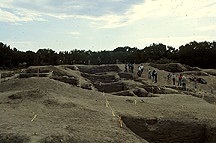

Since Context is so important to reconstructing human behavior, how do archaeologists use it? First, we need to explore the term "provenience." This refers to the location of artifacts and features.
The following pictures of an archaeological site in New Mexico called the Salmon Ruins illustrate the dimensions to the archaeology record that we think of as CONTEXT.... What is the most obvious thing you see in these pictures?

How does an archaeologist measure context?
The answer to that is ![]() simple. They measure the provenience of things. Test
your skills by locating the ordered pair for 200,150 on the map below. The
grid becomes a way of moving across space
and knowing exactly where you are. You are using the cartesian coordinate
system to locate points within the context of an archaeological site.
simple. They measure the provenience of things. Test
your skills by locating the ordered pair for 200,150 on the map below. The
grid becomes a way of moving across space
and knowing exactly where you are. You are using the cartesian coordinate
system to locate points within the context of an archaeological site.

Can you measure the location of the southern end of the ballcourt? What is the provenience for the center of the Platform Mound?
Remember the idea of a three-dimensional
jigsaw puzzle? The reconstruction of the archaeological record involves
three dimensions - horizontal space, depth (vertical space), and time. Context
is the ![]() relationship of artifacts and features across space
and over time. You should know that the control of time is vitally important
to archaeologists. Both the use of stratigraphy and dating methods such
as radiocarbon dating are critical to a reconstruction of the archaeological
record. Stratigraphy
is control of vertical space. Archaeologists study the natural position
of strata to understand vertical relationships.
relationship of artifacts and features across space
and over time. You should know that the control of time is vitally important
to archaeologists. Both the use of stratigraphy and dating methods such
as radiocarbon dating are critical to a reconstruction of the archaeological
record. Stratigraphy
is control of vertical space. Archaeologists study the natural position
of strata to understand vertical relationships.